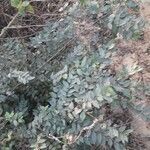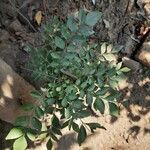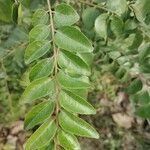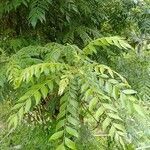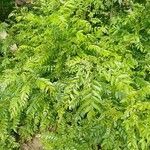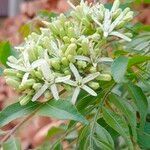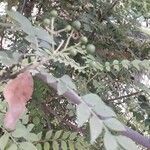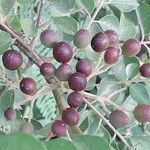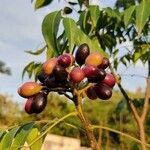| Therapeutic use
|
Antioxidants (aerial part), Analgesics (bark), Anorexia (bark), Anthelmintics (bark), Anti-bacterial agents (bark), Antiemetics (bark), Antifungal agents (bark), Anti-infective agents, local (bark), Anti-inflammatory agents (bark), Antineoplastic agents (bark), Antipruritics (bark), Antipyretics (bark), Appetite stimulants (bark), Bites and stings (bark), Colic (bark), Contusions (bark), Dermatologic agents (bark), Diarrhea (bark), Digestive system diseases (bark), Dysentery (bark), Dyspepsia (bark), Exanthema (bark), Flatulence (bark), Helminthiasis (bark), Hypoglycemic agents (bark), Inflammation (bark), Insecticides (bark), Leprosy (bark), Pain (bark), General tonic for rejuvenation (bark), Skin diseases (bark), Thirst (bark), Ulcer (bark), Vitiligo (bark), Vomiting (bark), Antifungal agents (flower), Digestive system diseases (flower), Eye diseases (flower), Anthelmintics (fruit), Antineoplastic agents (fruit), Antioxidants (fruit), Digestive system diseases (fruit), Insect bites and stings (fruit), Malaria (fruit), Increase physical endurance, strength and stamina (fruit), Cooling effect on body (fruit), Immunostimulant (leaf), Hair loss (leaf), Amnesia (leaf), Analgesics (leaf), Anorexia (leaf), Anthelmintics (leaf), Anti-bacterial agents (leaf), Anticoagulants (leaf), Antiemetics (leaf), Antifungal agents (leaf), Antihypertensive agents (leaf), Anti-infective agents, local (leaf), Anti-inflammatory agents (leaf), Antimutagenic agents (leaf), Antineoplastic agents (leaf), Antioxidants (leaf), Antipruritics (leaf), Antipyretics (leaf), Antitussive agents (leaf), Appetite stimulants (leaf), Arthritis (leaf), Asthma (leaf), Bites and stings (leaf), Blood glucose regulation (leaf), Burns (leaf), Cardiotonic agents (leaf), Chickenpox (leaf), Cholera (leaf), Cholesterol (leaf), Colic (leaf), Common cold (leaf), Contusions (leaf), Dandruff (leaf), Dermatologic agents (leaf), Diabetes mellitus (leaf), Diarrhea (leaf), Digestive system diseases (leaf), Dysentery (leaf), Dyspepsia (leaf), Edema (leaf), Emaciation (leaf), Epilepsy (leaf), Exanthema (leaf), Eye diseases (leaf), Eye pain (leaf), Fertility agents (leaf), Fever (leaf), Flatulence (leaf), Gastric acid (leaf), Hair diseases (leaf), Helminthiasis (leaf), Hematologic diseases (leaf), Hemiplegia (leaf), Hemorrhoids (leaf), Hypersensitivity (leaf), Hypoglycemic agents (leaf), Hypolipidemic agents (leaf), Inflammation (leaf), Insect bites and stings (leaf), Insect repellents (leaf), Insecticides (leaf), Jaundice (leaf), Kidney diseases (leaf), Laxatives (leaf), Leprosy (leaf), Leprosy, lepromatous (leaf), Increase leukocytes (leaf), Leukorrhea (leaf), Liver diseases (leaf), Malaria (leaf), Metabolism (leaf), Mosquito control (leaf), Nausea (leaf), Nootropic agents (leaf), Otitis media (leaf), Pain (leaf), Parasympatholytics (leaf), Pesticides (leaf), Pruritus (leaf), Rabies (leaf), Radiation-protective agents (leaf), General tonic for rejuvenation (leaf), Scabies (leaf), Skin diseases (leaf), Snake bites (leaf), Stomach diseases (leaf), Thirst (leaf), Ulcer (leaf), Urologic diseases (leaf), Uterine diseases (leaf), Visual perception (leaf), Vitiligo (leaf), Vomiting (leaf), Weight loss (leaf), Wound healing (leaf), Anti-dyskinesia agents (leaf), Delayed puberty (leaf), Platelet aggregation inhibitors (leaf), Analgesics (root), Anorexia (root), Anthelmintics (root), Anti-bacterial agents (root), Antiemetics (root), Antifungal agents (root), Anti-infective agents, local (root), Anti-inflammatory agents (root), Antiprotozoal agents (root), Antipruritics (root), Antipyretics (root), Appetite stimulants (root), Bites and stings (root), Cathartics (root), Colic (root), Contusions (root), Dermatologic agents (root), Diarrhea (root), Dysentery (root), Dyspepsia (root), Exanthema (root), Flatulence (root), Helminthiasis (root), Hemorrhoids (root), Hypertension (root), Inflammation (root), Kidney diseases (root), Laxatives (root), Leprosy (root), Malaria (root), Pain (root), General tonic for rejuvenation (root), Skin diseases (root), Stomach diseases (root), Thirst (root), Ulcer (root), Urologic diseases (root), Vitiligo (root), Vomiting (root), Wound healing (root), Anorexia (stem), Anti-bacterial agents (stem), Antifungal agents (stem), Antipyretics (stem), Dermatologic agents (stem), Malaria (stem), Mouth diseases (stem), Periodontal diseases (stem), Increase physical endurance, strength and stamina (stem), Anodyne (unspecified), Carminative (unspecified), Dysentery (unspecified), Eruption (unspecified), Kidney (unspecified), Nausea (unspecified), Stomachic (unspecified), Tonic (unspecified), Bruise (unspecified), Diarrhea (unspecified), Analgesics (unspecified), Anthelmintics (unspecified), Anti-bacterial agents (unspecified), Antiemetics (unspecified), Antifungal agents (unspecified), Antioxidants (unspecified), Antiprotozoal agents (unspecified), Antipyretics (unspecified), Appetite stimulants (unspecified), Astringents (unspecified), Bites and stings (unspecified), Dermatologic agents (unspecified), Diabetes mellitus (unspecified), Digestive system diseases (unspecified), Dysphonia (unspecified), Edema (unspecified), Emaciation (unspecified), Exanthema (unspecified), Hematologic diseases (unspecified), Hypoglycemic agents (unspecified), Infection (unspecified), Insecticides (unspecified), Kidney diseases (unspecified), Neurotic disorders (unspecified), Parasympatholytics (unspecified), Anti-poisoning (unspecified), General tonic for rejuvenation (unspecified), Skin diseases (unspecified), Tooth diseases (unspecified), Vitiligo (unspecified), Antiperiodic (unspecified), Cooling effect on body (unspecified), Antiemetics (whole plant), Antifungal agents (whole plant), Anti-inflammatory agents (whole plant), Antiprotozoal agents (whole plant), Appetite stimulants (whole plant), Digestive system diseases (whole plant), Dysentery (whole plant), Exanthema (whole plant), Flatulence (whole plant), Hypoglycemic agents (whole plant), Insecticides (whole plant), Parasympatholytics (whole plant), General tonic for rejuvenation (whole plant)
|
